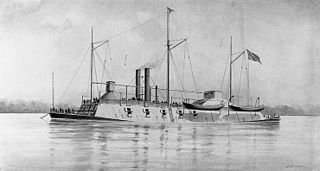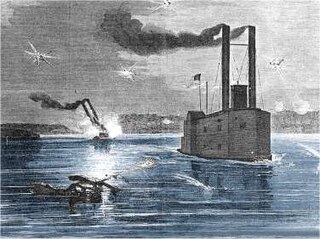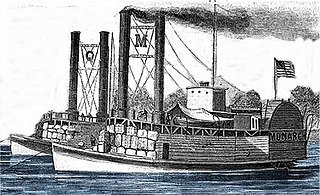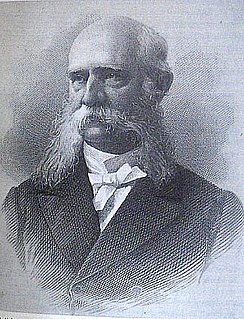The first USS Mingo, a stern-wheel steamer built at California, Pennsylvania, in 1859 and used to tow coal barges, was purchased at Pittsburgh by Colonel Charles Ellet Jr. in April 1862 for usage in the U.S. Ram Fleet during the American Civil War.
The first USS Mingo, a stern-wheel steamer built at California, Pennsylvania, in 1859 and used to tow coal barges, was purchased at Pittsburgh by Colonel Charles Ellet Jr. in April 1862 for usage in the U.S. Ram Fleet during the American Civil War.
She was fitted out as a ram at Pittsburgh and headed down the Ohio River 29 April to join a fleet of rams which Ellet was organizing to counter the Confederate River Defense Fleet. This group of southern rams had been fitted out in the lower Mississippi and threatened to emulate the dreaded southern ironclad ram Virginia in routing wooden hulled Union ships. On 10 May the Confederate flotilla made a spirited attack on Union gunboats and mortar schooners at Plum Point Bend, Tennessee, sinking Cincinnati and forcing the Mound City aground. A fortnight later all but one of the rams had joined the Union flotilla above Fort Pillow ready for action. As the ram fleet and Western Flotilla prepared to attack, General Halleck's capture of Corinth, Mississippi, on 30 May cut the railway lines which supported the Confederate positions at Forts Pillow and Randolph, forcing the South to abandon these river strongholds.
The Confederacy charged its River Defense Fleet, the only remaining operational group of southern warships worthy of the name fleet, with the task of stemming the Union advance down the Mississippi. The South's strategy called for a naval stand at Memphis, Tennessee.
On the evening of 6 June, Flag Officer Davis arrived above the city with his ironclads. Before dawn the next morning the Union ships raised their anchors and dropped downstream by their sterns. Half an hour later the Confederate rams got underway from the Memphis levee and opened fire.
At this point Colonel Ellet ordered his rams to steam through the line of Flag Officer Davis' slower ironclads and to run down the Confederate steamers. His flagship Queen of the West headed straight for Colonel Lovell, the leading southern ram. A moment before the two ships crashed, one of Colonel Lovell's engines failed causing her to veer. The Union ram's reinforced prow smashed into Colonel Lovell's side, ripping a fatal hole in her hull. When Queen of the West pulled free from Lovell, she ran aground on the Arkansas shore. Meanwhile, Union ram Monarch crashed into foundering Lovell with a second blow which sent her to the river bottom with all but five of her crew. By then Davis' ironclads had steamed within easy range of the southern ships and began to score with the effective fire. In the ensuing close action, the Confederate River Defense Fleet was destroyed; all of its ships, except the Van Dorn, were either captured, sunk, or grounded. Mingo and Lioness, ordered to protect the rear of Ellet's column, reached the scene of battle after the rout was over. Memphis surrendered to Flag Officer Davis, and the pressure of relentless naval power placed another important segment of the Mississippi firmly under Union control, an open wound in the Confederate heartland. During the next few days, the rams took on cannon to prepare to fight Confederate ships which they could not reach with their deadly prows.
On 19 June, Mingo and four sister rams got underway downstream from Memphis. A week later, after the rams had moved down the river to a point just above Vicksburg, Ellet sent a party across the peninsula, formed by a bend in the river opposite the hillside town, to tell Farragut, just below the fortress, that the Union had won control of the upper Mississippi. Farragut ran the gauntlet past Vicksburg's guns 28 June, and Flag Officer Davis joined him above the city with the Western Flotilla 1 July.
The meeting of the fresh water and salt water squadrons helped buoy morale throughout the North, but control of the river which it implied could not be realized until the South lost its Gibraltar-like fortress at Vicksburg. A year of seemingly endless labor and bitter fighting awaited the champions of the Union cause before President Lincoln could write: "The Father of Waters again goes unvexed to the sea..."
On 15 July, the Confederate ironclad ram Arkansas, built at Memphis and completed at Yazoo, Mississippi, raced down the Yazoo River and fought through the combined Union squadrons to shelter under the guns at Vicksburg. At the first sight of Arkansas, Lancaster tried to ram the southern ship; but when she was a mere 100 yards from her quarry, a broadside from the ironclad opened up her lines and made her unmanageable. As Lancaster drifted downstream, Queen of the West caught her and towed her to safety. The following day ram Mingo came alongside and took Lancaster to Memphis for repairs.
In the coming months Mingo and her sister rams worked tirelessly to control the river and to help capture Vicksburg. In November she sank accidentally at Cape Girardeau, Missouri.

CSS Arkansas was the lead ship of her class of two casemate ironclads built for the Confederate States Navy during the American Civil War. Completed in 1862, she saw combat in the Western Theater when she steamed through a United States Navy fleet at Vicksburg in July. Arkansas was set on fire and destroyed by her crew after her engines broke down several weeks later. Her remains lie under a levee above Baton Rouge, Louisiana at 30°29′14″N91°12′5″W.

USS Tyler was originally a merchant ship named A. O. Tyler, a commercial side-wheel steamboat with twin stacks and covered paddles positioned aft. Constructed in Cincinnati, Ohio in 1857, it was acquired by the United States Navy, 5 June 1861 for service in the American Civil War and converted into the gunboat USS Tyler on 5 June 1861. She was commissioned in September 1861. She was protected with thick wooden bulwarks.

The First Battle of Memphis was a naval battle fought on the Mississippi River immediately North of the city of Memphis, Tennessee on June 6, 1862, during the American Civil War. The engagement was witnessed by many of the citizens of Memphis. It resulted in a crushing defeat for the Confederate forces, and marked the virtual eradication of a Confederate naval presence on the river. Despite the lopsided outcome, the Union Army failed to grasp its strategic significance. Its primary historical importance is that it was the last time civilians with no prior military experience were permitted to command ships in combat. As such, it is a milestone in the development of professionalism in the United States Navy.

The USS Queen of the West was a sidewheel steamer ram ship and the flagship of the United States Ram Fleet and the Mississippi Marine Brigade. It was built at Cincinnati, Ohio in 1854. It served as a commercial steamer until purchased by Colonel Charles Ellet Jr. in 1862 and converted for use as a ram ship. The ship operated in conjunction with the Mississippi River Squadron during the Union brown-water navy battle against the Confederate River Defense Fleet for control of the Mississippi River and its tributaries during the American Civil War.

Charles Rivers Ellet was a colonel in the Union Army during the American Civil War. He served in the United States Ram Fleet under his father Charles Ellet, Jr. and as commanding officer of the ram fleet as part of the Mississippi Marine Brigade under his uncle Alfred W. Ellet. He commanded the ram ships USS Queen of the West, USS Switzerland, USS Lancaster and USS Monarch during the brown-water navy battle for control of the Mississippi River and its tributaries as part of the Vicksburg Campaign from 1862 to 1863.

USS Benton was an ironclad river gunboat in the United States Navy during the American Civil War. She was named for American senator Thomas Hart Benton. Benton was a former center-wheel catamaran snagboat and was converted by James B. Eads, St. Louis, Missouri, in 1861 and commissioned February 24, 1862 as part of the Army's Western Gunboat Flotilla.

The Mississippi River Squadron was the Union brown-water naval squadron that operated on the western rivers during the American Civil War. It was initially created as a part of the Union Army, although it was commanded by naval officers, and was then known as the Western Gunboat Flotilla and sometimes as the Mississippi Flotilla. It received its final designation when it was transferred to the Union Navy at the beginning of October 1862.

Alfred Washington Ellet was a brigadier general in the Union Army who commanded the United States Ram Fleet and the Mississippi Marine Brigade during the American Civil War.

The United States Ram Fleet was a Union Army unit of steam powered ram ships during the American Civil War. The unit was independent of the Union Army and Navy and reported directly to the Secretary of War, Edwin M. Stanton. The ram fleet operated in coordination with the Mississippi River Squadron during the Union brown-water navy battle against the Confederate River Defense Fleet for control of the Mississippi River and its tributaries.

US Ram Switzerland was a paddle steamer ram operated by the US Army during the American Civil War as part of the U.S. Ram Fleet and the Mississippi Marine Brigade.

USS Lancaster was a sidewheel civilian steamer tow boat built in 1855 at Cincinnati. It was originally named Lancaster Number 3 then Kosciusko. In March through May 1862, she was purchased and converted to a ram by Colonel Charles Ellet Jr. to serve during the American Civil War as part of the United States Ram Fleet and the Mississippi Marine Brigade.

USS Monarch was a United States Army sidewheel ram that saw service in the American Civil War as part of the United States Ram Fleet and the Mississippi Marine Brigade. She operated on the Mississippi River and Yazoo River during 1862 and 1863.

USS General Bragg was a heavy (1,043-ton) steamer captured by Union Navy forces during the American Civil War. She was outfitted as a U.S. Navy gunboat and was assigned to enforce the Union blockade of the waterways of the Confederate States of America.

CSS Colonel Lovell was a cotton-clad ram ship of the Confederate States Navy during the American Civil War

USS Indianola was a casemate ironclad that served as a river gunboat for the Union Navy during the American Civil War. A side-wheel steamer also equipped with two screw propellers, Indianola was built in Cincinnati, Ohio in 1862 by Joseph Brown before being taken by Union authorities while still incomplete, in response to a perceived Confederate threat to Cincinnati. After completion, the vessel briefly served on the Mississippi River and the Yazoo River before being sent downstream of Vicksburg, Mississippi in February 1863, to support the naval ram USS Queen of the West, which was operating against Confederate shipping.

Seth Ledyard Phelps was an American naval officer, and in later life, a politician and diplomat. Phelps received his first commission in United States Navy as a midshipman aboard the famous USS Independence. He served patrolling the coast of West Africa guarding against slavers. During the Mexican–American War he served on gunboats, giving support to Winfield Scott's army, and later served in the Mediterranean and Caribbean squadrons.

The Mississippi Marine Brigade was a Union Army amphibious unit which included the United States Ram Fleet and operated from November 1862 to August 1864 during the American Civil War. The brigade was established to act swiftly against Confederate forces operating near the Mississippi River and its tributaries. The brigade was commanded by Brigadier General Alfred W. Ellet and operated in coordination with the Mississippi River Squadron during the Union brown-water navy battle against the Confederate River Defense Fleet and land based forces. The brigade was independent of the Union Army and Navy and reported directly to the Secretary of War, Edwin M. Stanton. Despite the name, it was never part of the United States Marine Corps.

USS Winona was a Unadilla-class gunboat built for service with the Union Navy during the American Civil War. Winona was heavily armed, with large guns for duels at sea, and 24-pounder howitzers for shore bombardment. Winona saw significant action in the Gulf of Mexico and in the waterways of the Mississippi River and was fortunate to return home safely after the war for decommissioning.

USS Dick Fulton was a 123-ton stern-wheel steamer used as an auxiliary vessel in the United States Ram Fleet during the American Civil War.

Black Terror was a fake warship used in the American Civil War to bluff Confederate forces into destroying the partially-salvaged remains of the ironclad USS Indianola. Union forces were advancing to control the Mississippi River and had made two attempts to capture Vicksburg, Mississippi, in 1862. Early the next year, the ram USS Queen of the West moved downriver to interfere with Confederate shipping on the Red River; Indianola was sent down a few days later. However, Queen of the West was disabled and captured after an encounter with Confederate field fortifications, and Indianola was severely damaged on February 24 after an attack by the repaired Queen of the West and CSS William H. Webb.
This article incorporates text from the public domain Dictionary of American Naval Fighting Ships .The entry can be found here.